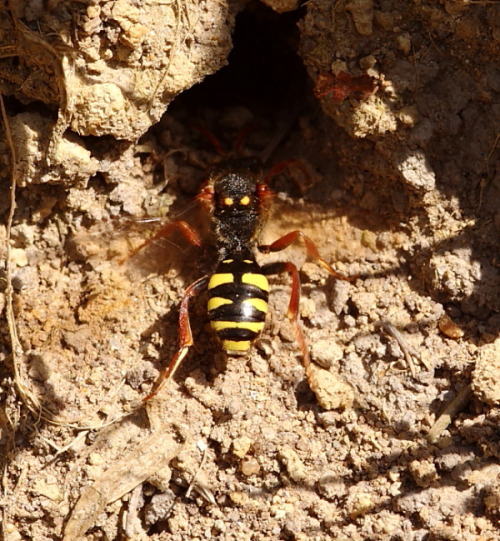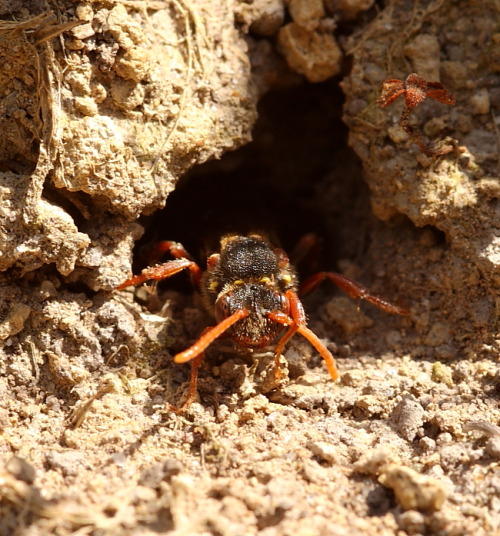Diptera.info :: Identification queries :: Other insects, spiders, etc.
|
Wasp id please?
|
|
| KerryN |
Posted on 19-05-2010 20:17
|
|
Member Location: Posts: 9 Joined: 19.05.10 |
I photographed this wasp but have so far not been able to identify it from the books that I have. It was photographed on the Llyn Peninsular in North Wales, UK. Would anyone be able to help? Many thanks Kerry KerryN attached the following image:  [160.3Kb] Edited by KerryN on 19-05-2010 20:19 |
|
|
|
| KerryN |
Posted on 19-05-2010 20:17
|
|
Member Location: Posts: 9 Joined: 19.05.10 |
front view
KerryN attached the following image:  [148.61Kb] |
|
|
|
| ChrisR |
Posted on 19-05-2010 20:46
|
|
Super Administrator Location: Reading, England Posts: 7706 Joined: 12.07.04 |
Looks like a parasitic bee called Nomada - there are many species but someone should be able to help 
Edited by ChrisR on 19-05-2010 20:46 Manager of the UK Species Inventory in the Angela Marmont Centre for UK Biodiversity at the Natural History Museum, London. |
| KerryN |
Posted on 19-05-2010 20:56
|
|
Member Location: Posts: 9 Joined: 19.05.10 |
ChrisR wrote: Looks like a parasitic bee called Nomada - there are many species but someone should be able to help  Ah, right so it is a bee rather than a wasp. Thanks for the pointer Chris. |
|
|
|
| ChrisR |
Posted on 19-05-2010 21:05
|
|
Super Administrator Location: Reading, England Posts: 7706 Joined: 12.07.04 |
Well, it certainly looks like Nomada to me ... to prove it was a bee you'd have to put it under a microscope and look to see if the hairs were branched. Wasps only have straight hairs but all bees have some hairs with tiny little branches along them 
Manager of the UK Species Inventory in the Angela Marmont Centre for UK Biodiversity at the Natural History Museum, London. |
| KerryN |
Posted on 19-05-2010 21:44
|
|
Member Location: Posts: 9 Joined: 19.05.10 |
ChrisR wrote: Well, it certainly looks like Nomada to me ... to prove it was a bee you'd have to put it under a microscope and look to see if the hairs were branched. Wasps only have straight hairs but all bees have some hairs with tiny little branches along them  I didn't realise that it was so hard to tell between the species. I have a lot of learning to do! :-) |
|
|
|
| ChrisR |
Posted on 19-05-2010 21:53
|
|
Super Administrator Location: Reading, England Posts: 7706 Joined: 12.07.04 |
Oh, there are about 7000 species of Hymenoptera (bees, wasps, ichneumons, sawflies & ants) in the UK alone - they are quite a difficult group to identify and specimens+microscopes are usually a must, unless you are lucky enough to have photographed an easy one  Bees are just an odd sub-group that have these branched hairs. They include the honeybees, bumblebees, solitary bees, parasite bees ... all kinds of wonderful things 
Manager of the UK Species Inventory in the Angela Marmont Centre for UK Biodiversity at the Natural History Museum, London. |
| KerryN |
Posted on 20-05-2010 06:18
|
|
Member Location: Posts: 9 Joined: 19.05.10 |
ChrisR wrote: Oh, there are about 7000 species of Hymenoptera (bees, wasps, ichneumons, sawflies & ants) in the UK alone - they are quite a difficult group to identify and specimens+microscopes are usually a must, unless you are lucky enough to have photographed an easy one  Bees are just an odd sub-group that have these branched hairs. They include the honeybees, bumblebees, solitary bees, parasite bees ... all kinds of wonderful things  Hi Chris How many of that seven thousand are bees and wasps? Regards Kerry |
|
|
|
| ChrisR |
Posted on 20-05-2010 08:48
|
|
Super Administrator Location: Reading, England Posts: 7706 Joined: 12.07.04 |
Tricky question - mainly due to the definition of "wasp"  Bees are fairly easy - there are about 260-270 species of those (1 honey bee plus bumblebees and lots of solitary bee species). Wasps are harder because virtually all the other 6700 species that aren't ants (there are about 50 ant species here) are variously called 'wasps' but if you mean social wasps (the black & yellow jobs) then there are about 10 species of those ... the rest are the sawflies (herbivorous wasps), cynipids (gall wasps), chalicids (a big parasitoid group), ichneumons (a huge parasitoid group), solitary wasps and plenty of others too numerous to mention  Chris R. Manager of the UK Species Inventory in the Angela Marmont Centre for UK Biodiversity at the Natural History Museum, London. |
| KerryN |
Posted on 20-05-2010 13:50
|
|
Member Location: Posts: 9 Joined: 19.05.10 |
I had never realised there were so many different types of bee in this country. I keep honey bees so I recognise that one! Many thanks for responding Chris. Regards Kerry |
|
|
|
| Jump to Forum: |













